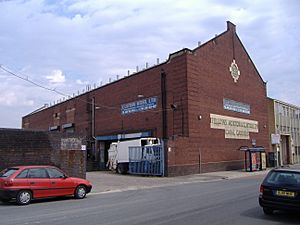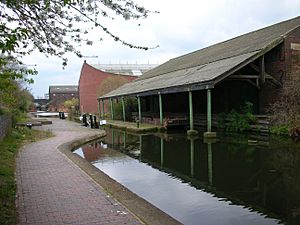Warwick Bar facts for kids
The Warwick Bar conservation area is a special protected area in Birmingham, England. It was once a busy place with many factories built next to the canals during the time of the Industrial Revolution. This was when many new machines and factories were created in the 1700s and 1800s.
The area gets its name from the Warwick Bar and later the Warwick Bar stop lock. This is a special spot where the Digbeth Branch Canal meets the Warwick and Birmingham Canal (which is now part of the Grand Union Canal).
Contents
Warwick Bar: A Special Place
The Warwick Bar Conservation Area is a large protected space, about the size of 40 football fields (16.2 hectares). It's where the big Grand Union Canal (which goes all the way to London) meets the Digbeth Branch Canal. This area was made a special conservation area on June 25, 1987. It includes the whole Digbeth Branch Canal in the Eastside part of Birmingham and even a bit of the River Rea.
This area is home to many important old buildings. Three of them are officially "listed buildings," meaning they are protected by law because they are historically important. These were built by the canal company in the 1840s and 1850s. There's also a canal warehouse built in 1935 that is locally listed. In total, there are five officially listed buildings and six locally listed ones. Sadly, one locally listed building, an old Co-op furniture factory from 1899, was badly damaged by a fire in 2007.
New Plans for Warwick Bar
Since 2005, a part of the Warwick Bar conservation area has been getting a makeover. This is part of a bigger plan called the Birmingham Eastside development. The goal is to fix up old buildings that have become run-down.
Developers have big plans for this area, including building a large casino and hotel. The city council gave their first approval for these plans in 2013. This decision was made partly because of the new HS2 high-speed train route coming into the city. Even English Heritage, a group that protects historical places, agreed to the changes for the listed buildings. They saw the economic benefits this project could bring to the Digbeth area.
Many ideas for new buildings have been suggested. Most of these plans are for new homes. They will either replace old warehouse buildings or give them a new life. In 2005, a competition was held to find the best designs for the area. Many companies sent in their ideas. The winners, Kinetic AIU, are working with other groups to create a final plan. This plan includes a film center, an art gallery, a hotel, and places for people to meet. About 600 new homes are planned for the area. This big project, costing around £100 million, aims to finish by 2013. It also includes fixing up the old Fellows Morton and Clayton building and the Banana Warehouse.
Another project in the area is called The Bond. This project turned old Victorian factory buildings next to the Grand Union Canal into offices and media spaces. The most interesting part of The Bond is The Ice House, built in 1890. It used to make 40 tons of ice in just over a day! This ice was then used in markets. The Ice House and other canal buildings around it are locally listed. The World Wildlife Fund is one of the groups that has offices at The Bond.
Warwick Bar Stop Lock: A Clever Design
The Warwick Bar stop lock is a very interesting part of the canal system. 52°28′47″N 1°53′00″W / 52.47985°N 1.88338°W
Originally, the Warwick and Birmingham Canal and the Digbeth Branch were built by different companies. There was a physical gap between them. Boats had to unload their goods on one side and then load them onto another boat on the other side. This was a lot of work!
Later, the canal companies agreed to build a "stop lock." This was a smart way to let boats move between the two canals without wasting too much water. A stop lock has two sets of gates. This design means that very little water is lost when a boat passes through, no matter which canal is higher at the time. Today, the gates are kept open because both canals are now managed by the same group.
Next to the stop lock is the Banana Warehouse. It has a roof that hangs over the canal. It's called the Banana Warehouse because a company named Geest, which dealt with bananas, used to own it. Both the stop lock and the Banana Warehouse are important historical buildings, listed as Grade II.
You can get to the towpath (the path next to the canal) from the bridge at Great Barr Street or where Fazeley Street crosses the Typhoo Branch.
Important Buildings and Structures

Here are some of the important listed buildings and structures in the Warwick Bar area:
- Locally listed – former 1935 Fellows Morton and Clayton building – Grade C
- Locally listed – 180–182 Fazeley Street – Grade B
- Locally listed – former Bond warehouse – Grade A
- Locally listed – Grand Union Canal aqueduct over River Rea – Grade B
- Locally listed – part of River Rea – Grade C


